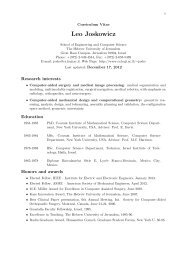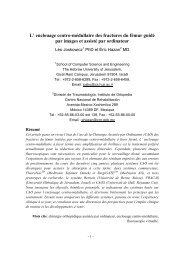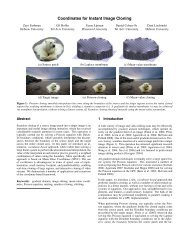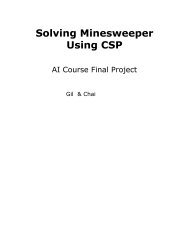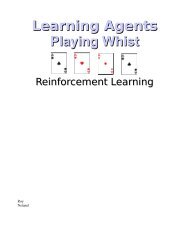TEL AVIV UNIVERSITY Gaddi Blumrosen
TEL AVIV UNIVERSITY Gaddi Blumrosen
TEL AVIV UNIVERSITY Gaddi Blumrosen
You also want an ePaper? Increase the reach of your titles
YUMPU automatically turns print PDFs into web optimized ePapers that Google loves.
Jake‟s model describes sum of discrete multi-path model each one has time-selective<br />
fading distribution (e.g., Rayleigh fading distribution).<br />
Coherence bandwidth, f c , is the frequency separation for which frequency-space<br />
correlation function of channel impulse response (see [3, p 52.] for graph of<br />
correlation versus DOA and frequency) at two frequencies is sufficiently correlated<br />
(exceeding predetermined threshold). The Coherence frequency is inversely<br />
1<br />
proportional to Delay spread, i.e., Fc<br />
. When coherence bandwidth is several<br />
d s<br />
times larger than the inverse of Symbol time, the channel is called frequency nonselective<br />
fading channel, or flat fading channel, if not the fading is called, frequency<br />
selective fading.<br />
Space-selective fading<br />
Space-selective fading, the variations of signal in space, is caused by different<br />
receiver departure angles of the multi-paths due to reflection, scattering and<br />
diffraction from scatterers (include obstacles such as buildings) in the propagation<br />
path. In LOS conditions, there is low space selectivity. Space selectivity is determined<br />
by antenna spacing, scatterers‟ distribution (mainly angle spread) and wave length.<br />
Different scatterers‟ distribution models are well summarized in [3, p 63-91]. A<br />
popular assumption (not realistic in correlated fading) is uniform distribution over<br />
[ 0,<br />
2<br />
) or over the Angle Spread.<br />
Coherence distance, c , is the angle or space separation for which channel response<br />
at two antennas is sufficiently correlated (exceeding determined threshold). The<br />
1<br />
Coherence distance is inversely proportional to angle spread, i.e., c<br />
. If<br />
as<br />
coherence distance (proportional to angle spread) is several times larger than the<br />
antenna spacing, the channel is space non-selective fading cahnnel. If not, the fading<br />
is called, space selective fading. Table 1 below (taken from [23]), summarize the<br />
relations between channel parameters.<br />
Spatial Noise<br />
The noise in space time models is sometimes referred to as spatial noise with spatial<br />
statistics which is related to scatterers‟ distribution. For instance, in a multi-user<br />
environment, transmission from different users in different locations, are spatial<br />
sources contributing to noise distribution. Spatial distribution of the scatterers (other<br />
users) which depends on spatial location is referred to as "colored noise". For<br />
simplicity, we will assume from now on, unless mentioned otherwise, that the noise is<br />
independent of the space dimension, and it is a stationary white Gaussian process<br />
(AWGN). We will denote this noise as n<br />
t .



